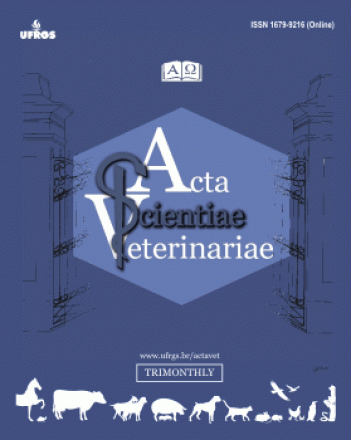Detecção do vírus da diarreia viral bovina em carrapatos Rhipicephalus (Boophilus) microplus alimentados em bovino persistentemente infectado
Acta Scientiae Veterinariae
Detecção do vírus da diarreia viral bovina em carrapatos Rhipicephalus (Boophilus) microplus alimentados em bovino persistentemente infectado
Autor Correspondente: CláudioWageck Canal | [email protected]
Palavras-chave: bovine viral diarrhea virus, rhipicephalus (boophilus) microplus, tick, transmission, vector
Resumos Cadastrados
Resumo Inglês:
Background: Bovine viral diarrhea virus (BVDV) is one of the main agents that cause economical losses in cattle worldwide.
Congenitally infected calves that are born persistently infected (PI) to BVDV are the main sources of infection to susceptible
cattle. Direct contact is the most important form of transmission, but indirect contact can also spread BVDV, not only inside
herds, but also between them. Transmission of BVDV by haematophagous insects has been proven experimentally, but the role
of ticks in the transmission of BVDV has never been investigated. Ticks can heavily infest cattle raised in tropical areas and
Rhipicephalus (Boophilus) microplus is the most important among them. The present experiment was carried out to investigate
the role of R. microplus ticks in the transmission of BVDV, experimentally infecting PI calf with ticks.
Material, Methods and Results: Three calves were used in the experiment: one PI calf was identified from a natural outbreak;
a second animal was infested with the progeny of a tick fed on the PI calf and the third was kept as a negative control, infested
with negative ticks. Viral RNA investigation was performed by reverse transcription followed by polymerase chain reaction
(RT-PCR) from the sera of the calves and from ticks (adult females, eggs and larvae that were the progeny of the experimentally
contaminated adult females and from the control animal). BVDV RNA was detected in tick adult females fed on the PI calf, but
not in the control animal. Experimental infestation of a second cattle with larvae derived from adult females infected with
BVDV was not able to produce infection. These data suggest that the virus is able to pass to ticks during feeding on the infected
PI animal, but that there is no transmission by transovarial route, as viral RNA was not detected in eggs and larvae from adult
females infected with BVDV.
Discussion: Bovine tick is the most important ectoparasite in domestic animals in tropical and subtropical areas. However, its
role in transmission of viral agents, particularly BVDV, has not been previously studied. The results of our experiment
suggested that adult females of R. microplus were not able to transmit the infection to susceptible cattle. However, a macerate
of a pool of tick females fed on the PI calf was positive to BVDV. A further validation using a larger number of infested bovines
would help to confirm this new finding. R. microplus ticks are monoxenic, but it must be considered that the males, different
from females, make a non-continual process of blood sucking and may move between bovines to reproduce. Additionally, in
conditions of close contact between animals, besides tick males, larvae may change hosts in the early stages of development.
These facts do not permit to exclude the risk of direct spread of viral infection in the herd by a same specimen of R. microplus.
On the other hand, the presence of virus inside females represents an environmental reservoir of BVDV, which may infect
through epithelial abrasions if ingested. These considerations may be reinforced by the fact that in field conditions it has been
observed that high animal density favors the fast spread of BVDV in cattle herds. Collectively, these evidences suggest that
ticks would represent an additional factor to be allowed for in BVDV transmission. As a conclusion, the present study
demonstrates that R. microplus can be contaminated with BVDV during blood feeding, strengthening the idea that
haematophagous vectors can be involved in the spread of the disease. In spite of the fact that BVDV was not transmited by the
progeny of the ticks, it is not possible to discard such form of transmission under natural conditions.

